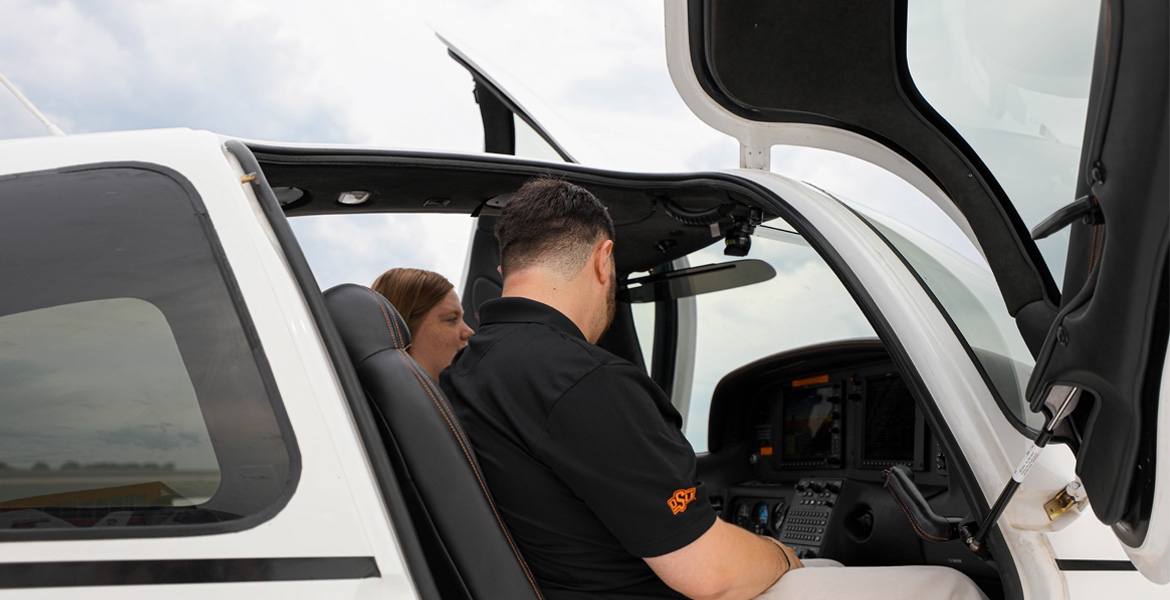
CEAT researcher focuses on changing flight instructors’ lives (and schedules)
Monday, July 8, 2024
Media Contact: Savannah McDaniel | Events Specialist | 405-744-1292 | savannah.mcdaniel@okstate.edu
You wake up at 5:45 a.m. to get to work right at 6:30. You jot down notes and start your first meeting at 7 a.m. You finish the meeting by 9, and by 9:30, you’re writing more notes before heading into another meeting at 10. You get a lunch break and repeat this process 2-3 more times until you can finally go home by 9 p.m.
This can be a typical day for a certified flight instructor. Except notes are pre-flights, and meetings are flights, or lessons, with students.
By the next day, you may just have one flight due to bad weather. Then, that weather could last the remainder of the week and you don’t fly the rest of the time — only meeting half or less of your hours.
Dr. Nicoletta Fala, an Oklahoma State University College of Engineering Architecture and Technology Mechanical and Aerospace Engineering assistant professor, is conducting research to address how having such an irregular and demanding schedule could cause fatigue and burnout among flight instructors nationwide, resulting in safety and quality of training to be negatively impacted.
Fala, a flight instructor herself, knows about fatigue on the job all too well. When she was a flight training student, she had an instructor fall asleep in the middle of a flight.

“I was doing my instrument training, and I was flying with foggles on, which means I cannot see outside,” Fala said. “I can only see my instruments; the instructor is supposed to keep an eye out for other aircraft and obstacles. We were flying for about 15 minutes, and he wasn’t saying anything. Air traffic control had asked me something, and I asked for his opinion before replying and received no response. I then looked over and realized he was asleep.”
Fortunately, she was able to wake the instructor and land the plane safely.
When given the opportunity to work on this research, she jumped on it.
“When this opportunity came up, I said, ‘Yes, because that’s happened to me,’” Fala said. “If it has happened to me, it probably has happened to other people, too.”
Fala and her team have conducted focus groups in multiple states. Through these focus groups, the team aims to study the feelings of fatigue and burnout and find ways to reduce them through potential incentive strategies or work reorganization.
“One of the things that keeps coming up is pay,” Fala said. “They just don’t make enough money. Which results in people falling asleep in the plane while instructing because they can’t make the decision to cancel their flight because if they cancel, they can’t make rent.”
To combat this, Fala’s team is considering different options, such as switching from hourly pay to salary pay, or having two different structures where student instructors are part time and can only have two students, and full-time instructors can only take six or seven students. Another suggestion is having the number of students be based on the instructor’s performance, which would be based on student evaluations.
Another recommendation is changing the culture and having more fun.
“The instructors start out highly motivated and they want to be good instructors and do the best they can, and then they end up just trying to get out of here,” Fala said. “Most flight instructors are in a strange situation where they are working on developing new pilots while also building up their own experience; they tend to work as many hours as they can to build the required experience to get to their full-time job.
“We want to change the culture to where they continue to be motivated. Allow them to do fun flights without students, because when you’re instructing, you’re not getting to touch the controls much. We want them to be able to fly on their own and remember that they like what they’re doing.”
Instructors see the benefits of the study and what it could mean for the future.
“Being a flight instructor is not like a normal job where you go 9-5,” said James Windham, CFI at the OSU Flight Center and an OSU alumnus. “It may be 7 a.m. to 10 a.m., and then 1 to 5, and 7-9 p.m. Finding a way to make our days a little more balanced would be great, especially when it comes to pay. There are some weeks we make all of our hours, and then the next, we get zero because of bad weather.
“It’s really cool to see someone doing research on how our lives are affected by being flight instructors. Doing this research to make us all better, safer pilots can only be a good thing.”
Fala said when instructors are rested, they can provide better quality training.
“It will improve not only their own lives but also their students' lives,” she said. “Our findings will impact flight students and instructors everywhere.”

